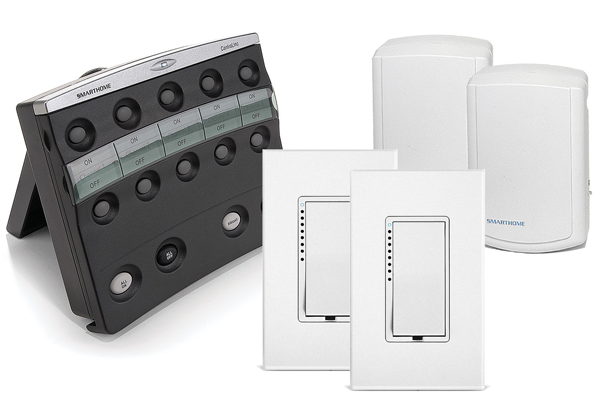Reader's Voice: An Introduction To Home Automation
Introduction
Many of us have seen sci-fi movies where the characters come home, walk in the front door, and their lights turn on for them. Perhaps they tell the house to switch on the TV or bring up the video phone with its wall-sized screen to call a friend.
Unfortunately, we're not quite "there" yet with regard to commercially-available home automation technology. But you might be surprised at how much can be achieved by the enthusiast looking to advance his home into the 21st century. Let me show you some of the shipping protocols and options. Then, we'll walk through the purchase process and installation to see what it takes to turn a house into a modern-day electronic toy.
Before we get ahead of ourselves, lets talk a little about what home automation is, exactly. HA, short for home automation, is a technology class that enables automatic and/or remote control of household electronics. The most commonly connected devices in an HA implementation are usually lamps/over-head lighting, heating/air conditioning, lawn and garden irrigation, and security systems.
One of the vendors we looked at, SmartHome, seems fairly biased by their near-exclusive offering of Insteon products. But the company does have some convenient information on HA, including a chart of the available technologies. You can check that out right here.
We'll dig into more of the differences, considerations and available options later.
Interview with George Hanover
First, we wanted to talk to an expert in the field and find out why home automation isn't more popular among computing enthusiasts than it is today. We exchanged emails with George Hanover, a fellow and membership chair of the IEEE Consumer Electronics Society, to find out more.
Get Tom's Hardware's best news and in-depth reviews, straight to your inbox.
Tom's Hardware: Why isn't home automation more pervasive today?
George: Well it is catching on, albeit slowly. “Buying” home automation is not like buying an appliance or even a home theater system. A customer can be shown a new refrigerator or TV set, but how does a salesman effectively demonstrate home automation? Also, all of the user devices must be compatible with each other and with the HA system so that they can talk to each other.
So, when a customer buys in to a particular system, he/she is really making a long-term commitment.
Tom's Hardware: We'd think that a basic home automation setup could be deployed for less than the price of a mid-grade computer. Many households have two or more computers these days. Is it the installation process scaring most folks off?
George: Also, there’s the matter of retrofitting into the existing housing inventory. Each year, only a tiny percentage of the housing stock is new, which means the biggest market for HA is in existing homes, and some of them have been around for 40+ years.
Tom's Hardware: Most people don't install irrigation systems themselves. Instead, they hire a contractor to perform the installation. Are there home automation installers, and are they difficult to find?
George: Yes, there are, and no they’re not.
Check the Customer Electronic Design and Installation Association (CEDIA) Web site at http://www.cedia.net/. You will see an installer locater and also find that CEDIA has a certification program for installers and holds an annual expo. Also, I think the level of expertise needed to install a first-rate HA system is much higher than needed to install an irrigation system.
-
Gin Fushicho Sounds like a lot of fun, though my Grandpa wouldnt like it , he likes to work too much. =/ He might like setting it up though.Reply -
Twoboxer IMO, the problem with "Home Automation" is thatReply
(a) it's fragmented
(b) most applications can be accomplished in most homes with less expensive, individual systems than with any integrated system - even if one existed.
HVAC: Unless you have a large home requiring multiple HVAC zones/thermostats, and unless parts of the home are unoccupied for varying amounts of time, a programmable thermostat is an adequate solution. Setbacks (eg while you are at work) don't seem to save much money with modern HVAC systems in most US climates.
Lighting: If "security" means cycling lights so the house looks occupied, again simple timers are adequate. Unless you have a large, multi-source lighted home, few need automated lighting and "scenes".
Irrigation: If you have any sprinkler system, once again timers and rain sensors do the job well enough.
And so on.
FYI, I have a large primary residence with a networked security system that also controls multiple thermostats. A dedicated PC has replaced a stand-alone DVR to monitor security cameras. A low-voltage, microprocessor controlled system controls lighting.
If these 8-year old systems talked to each other well, maybe I could use the motion detectors to automatically turn lights on and off. And maybe I wouldn't be better off using standard internet cameras to monitor security as I travel between homes.
Its all cool technology, but as a substantial user and tech-lover, I just don't see significant, practical application in most homes. -
Twoboxer Please forgive the double-post, but I couldn't resist pointing out one savings I learned about from all of this.Reply
I use a lot of 130V bulbs in the fixtures controlled by microprocessor controlled lighting system. Most of these bulbs are also oversized for their purpose, and are therefore set to run at, eg, 60% or 75% of maximum voltage when turned on.
I don't know whether I've saved any electricity or not - I doubt it lol - but I have saved a tremendous amount of money on bulbs. EG, there are 11 such bulbs in my kitchen ceiling and they run a minimum of 12 hours per day. I have not replaced a bulb in that set since they were installed over 8 years ago. -
mrubermonkey Buying proprietary systems is bad. Go with equipment that goes by industry standards and the whole issue with home automaton being a long-term investment goes away for the most part. Unless some company's proprietary technology always leads industry standards by leaps and bounds, but this is rare.Reply -
pratik77 If you want the real deal, go for Crestron.Reply
Sure it costs money but so does liquid nitrogen cooled overclocked gaming rigs. -
On the life of light bulbs . . . .Reply
Lamp life is very sensitive to operating voltage - for 120 volts Ge quotes 125 volts as shortening the lamp life to 1/2 and 130 volts to 1/3. The inverse is true - if you put a 130 volt lamp in a 120 volt circuit you can expect over double the lamp life, and if you have a dimmer to soft start then it can last a way lot longer.
http://www.gelighting.com/na/business_lighting/faqs/incandescent.htm -
How can you not mention http://www.CocoonTech.com, the largest DIY home automation site out there.Reply
-
sublifer cocoonerHow can you not mention http://www.CocoonTech.com, the largest DIY home automation site out there.It was mentioned on page 3:Reply
Many of the searches for further guidance landed me at cocoontech.com, and reading other people's guides and questions helped me through the process.

